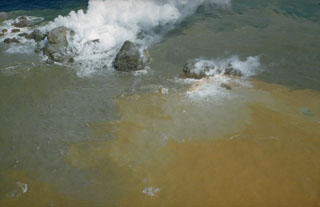Report on Myojinsho (Japan) — October 1987
Scientific Event Alert Network Bulletin, vol. 12, no. 10 (October 1987)
Managing Editor: Lindsay McClelland.
Myojinsho (Japan) Discolored water within 100 km
Please cite this report as:
Global Volcanism Program, 1987. Report on Myojinsho (Japan) (McClelland, L., ed.). Scientific Event Alert Network Bulletin, 12:10. Smithsonian Institution. https://doi.org/10.5479/si.GVP.SEAN198710-284070
Myojinsho
Japan
31.888°N, 139.918°E; summit elev. 11 m
All times are local (unless otherwise noted)
Discolored water within a 100-m radius of Myojin-sho, the central cone of the submarine volcano, was recognized by observers on a fishing boat at 1040 on 21 October. No discolored water had been seen at 0603 that day and none was seen the next day during a JMSA overflight.
Geological Summary. Beyonesu Rocks are part of the barely exposed rim of the largely submarine Myojinsho caldera. Formation of the 8-9 km wide caldera was followed by construction of a large (2.6 km3) lava dome and/or lava flow complex on the caldera floor, originally located at a depth of 1,000-1,100 m. Most eruptions recorded since the late-19th century have occurred from the dacitic post-caldera Myojinsho lava dome on the NE caldera rim. Deposits from submarine pyroclastic flows associated with growth of the dome cover it and extend both into the NE part of the caldera and down its outer slopes. An explosive submarine eruption from Myojinsho in 1952 destroyed a Japanese research vessel, killing all 31 on board. Submarine eruptions have also been observed from other points on the caldera rim and outside of the caldera. The Beyonesu Rocks were named after the French warship the Bayonnaise, which was surveying volcanic islands south of Tokyo Bay in 1850.
Information Contacts: JMA.

